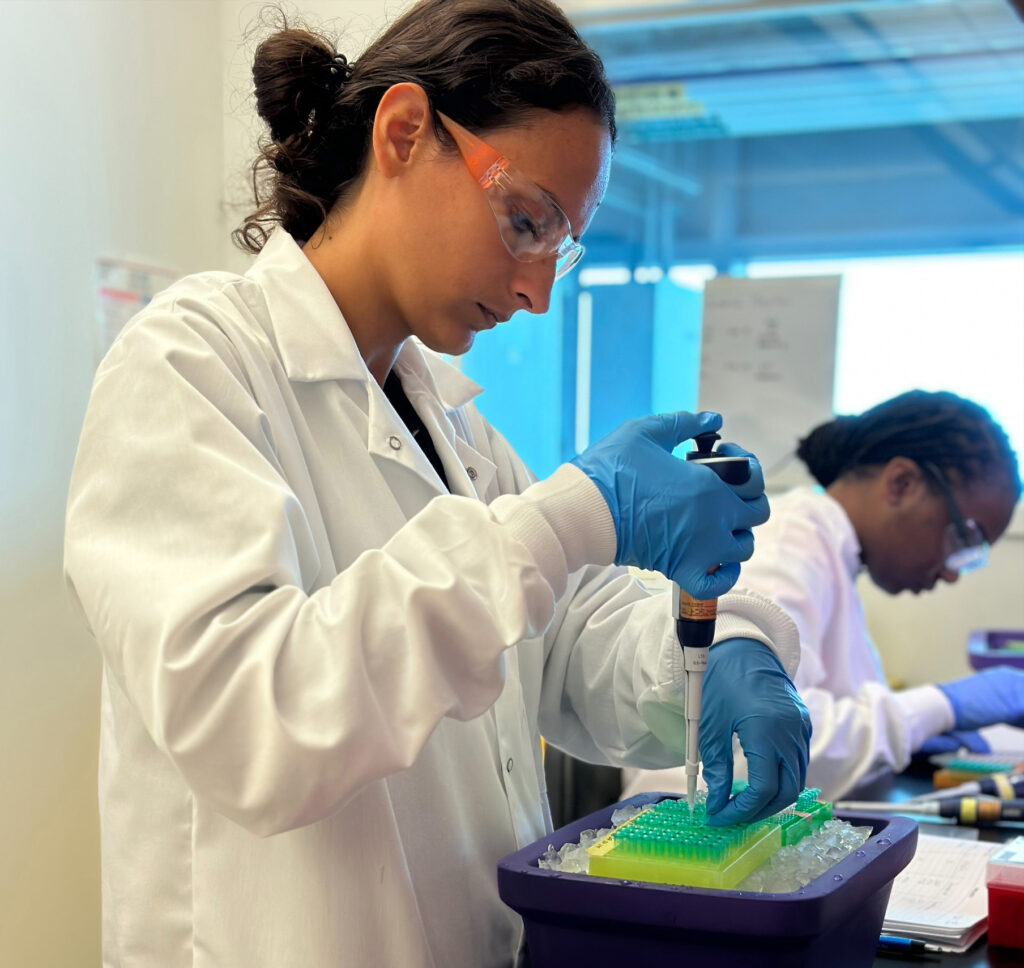To Help Stop Malaria’s Spread, CDC Researchers Create a Test to Find a Mosquito That Is Flourishing Thanks to Climate Change
For years, climate scientists have cautioned that the warming world could create conditions where animals, insects and other creatures would establish themselves in places they had not been found before—and bring diseases harmful to humans with them.
That scenario is now playing out in Africa, where a mosquito native to Asia has found a new home on the planet’s second-largest continent—and, as a prime carrier of the parasite that causes malaria, poses an increased public health threat to nearly 130 million people.
The mosquito—the notorious Anopheles stephensi—is not only adaptable, but it also bears a striking resemblance to most other insects in its genus, making it difficult for researchers, government officials and just about anyone else to determine which bug is which.
That is, until earlier this year. Researchers at the Centers for Disease Control and Prevention recently announced that they have developed a new test that allows for the rapid identification of the disease-transmitting insect, giving communities where the mosquito is migrating a chance to move quickly to eradicate it and address potential malaria infections.
Explore the latest news about what’s at stake for the climate during this election season.
“We set out to create a test that would not only be quick, but it would be affordable, it would be field friendly and easy to interpret,” said Cristina Rafferty, a molecular biologist at the CDC, who helped lead the effort to develop the test. “It’s easy, it’s fast, and we’re hoping that it will allow countries to be able to detect that quickly and then inform their national malaria programs to act quickly in trying to stop the spread.”
The test, called the class assay, works by placing insect samples in a test tube, adding a chemical mixture, and warming it. Results can be obtained in about a half hour.
Under the previous system, Rafferty said, tests to confirm the type of mosquito could only be conducted using “very specialized equipment, a lot of training, laboratories that are well set up and costly.”
And reading results using the class array is as straightforward as a home COVID test. “It is a color-changing assay,” Rafferty said. “It changes from pink to yellow if you have Anopheles stephensi.”

The development of the class assay is something of a full circle moment for the CDC, which was created in 1957 to eradicate malaria—a charge that it virtually fulfilled. Malaria cases are exceedingly rare in the United States. Cases that were identified in Florida and Texas last summer were the first locally acquired occurrences of the disease in two decades.
It is a decidedly different story around the world—there were roughly a quarter of a billion cases of the disease globally in 2020, which resulted in more than 620,000 deaths.
Malaria does not spread from human-to-human, but through insects that bite one person and carry the malaria-causing parasite to another. Symptoms of the disease include fever, flu-like illness, nausea, vomiting and diarrhea.
The World Health Organization launched an initiative in 2023 to curb the insect’s spread. WHO officials noted that since 2012, Anopheles stephensi has been detected in seven African nations: Djibouti, Ethiopia, Sudan, Somalia, Nigeria, Ghana and Kenya.

Rafferty said that it’s difficult to overstate the impact of global warming on the insect’s ability to find new habitats.
“Conditions are warmer, there’s more climate events, floods and all of these things are conducive for mosquitoes to breed,” she said. “And then you have people who are traveling from other countries and they may bring malaria with them. All it takes is a mosquito to bite them, and then the parasite develops. And then they go bite somebody else. And there you go.”
Many mosquitoes proliferate in standing water during the rainy season in tropical areas, and are usually unable to weather dry spells. But Anopheles stephensi is particularly hardy, Rafferty said.
“This mosquito also tends to persist in drier conditions and for extended periods of time, which means now the seasonality of malaria—where it comes with rainy seasons—would not be an issue anymore,” Rafferty said. “You’d see malaria year-round.”
While it’s clear that global warming is changing the habitats of insects, scientists say that they are still trying to determine how climate change might affect rates of malaria around the world.
“Malaria is transmitted by Anopheles mosquitoes, and both the development of the parasite in the mosquito and also the life of the mosquito—how its survival and reproduction are all climate driven,” said Photini Sinnis, professor at the Bloomberg School of Public Health at Johns Hopkins University and deputy director of the university’s Malaria Research Institute.
“The size of a mosquito population will depend on the climate, and the speed with which the parasite develops in the mosquito depends on temperature,” Sinnis said. “And so malaria is really a climate-driven disease in many ways. And I think the only thing we can definitively say is that climate change will impact malaria transmission. But I think that we don’t know how, and that its impact will likely be different in different parts of the world.”
After the past year—in which the planet notched a record-high temperature each month—the extent of those impacts will be exacerbated by increasingly hotter seasons.
“When you have these hot, humid summers, mosquitoes can live longer,” Sinnis said. “And when the warm weather starts earlier—like, if it starts in February rather than in April—the mosquitoes can start reproducing earlier. And so what you end up having is just a larger population of mosquitoes. And if you have a larger population of mosquitoes, and we have all these travelers that go to malaria-endemic areas and they come back and some of them don’t take their prophylaxis, when they come back, they may have malaria infections.”
Judith O’Donnell, an infectious disease specialist at the University of Pennsylvania, said that the class array test might be a particularly important tool in identifying malaria cases in large cities.
Unlike other malaria-spreading mosquitoes, which prefer laying their eggs in freshwater locations, O’Donnell said that Anopheles stephensi “is actually an urban mosquito, and it’s fine with preferentially laying its eggs in, you know, the places where urban mosquitoes lay their eggs,” such as standing water or liquid in abandoned tires or open containers.
“So having that test available is really because there’s this ongoing concern that eventually—with climate change and with longer breeding seasons—that if we see this particular Anopheles mosquito, it could really be a risk for urban transmission in warm areas,” she said. “If we start seeing that mosquito in the United States, transmitting or getting a foothold here, then there’s more concern that we’re going to see more widespread malaria in, potentially, urban areas.”
Global warming may cause disease specialists to rethink how malaria is spread, O’Donnell said.
“In the setting of climate change, doctors are going to have to start thinking about malaria as a cause of disease very differently,” she said. “It’s not just going to be in the returning traveler. It could be similar to how we think about West Nile virus, for example. In the future, it’s possible that we’ll have a malaria season similar to the way we have West Nile virus season.”
Sinnis noted that while the Anopheles stephensi mosquito is not found in the United States, malaria was once prevalent across the nation, with upward of 800,000 cases each year in the early 1900s.
Though the disease was virtually wiped out domestically in the 1950s, last year’s cases—which were found in Maryland, Florida and Texas—have made Sinnis more vigilant about U.S. spread.
“I’m watching this summer,” said Sinnis, who noted that last year’s cases were found in three geographic locations, which is very rare in the U.S. “Are we going to have malaria cases in the United States again? Is this going to become more regular? And then if it does become more regular, is this going to get larger, so will we have sort of small epidemics? Small outbreaks of malaria throughout the United States in the summer? I don’t know the answer to that, but that’s what we would be watching for, in the future.”
About This Story
Perhaps you noticed: This story, like all the news we publish, is free to read. That’s because Inside Climate News is a 501c3 nonprofit organization. We do not charge a subscription fee, lock our news behind a paywall, or clutter our website with ads. We make our news on climate and the environment freely available to you and anyone who wants it.
That’s not all. We also share our news for free with scores of other media organizations around the country. Many of them can’t afford to do environmental journalism of their own. We’ve built bureaus from coast to coast to report local stories, collaborate with local newsrooms and co-publish articles so that this vital work is shared as widely as possible.
Two of us launched ICN in 2007. Six years later we earned a Pulitzer Prize for National Reporting, and now we run the oldest and largest dedicated climate newsroom in the nation. We tell the story in all its complexity. We hold polluters accountable. We expose environmental injustice. We debunk misinformation. We scrutinize solutions and inspire action.
Donations from readers like you fund every aspect of what we do. If you don’t already, will you support our ongoing work, our reporting on the biggest crisis facing our planet, and help us reach even more readers in more places?
Please take a moment to make a tax-deductible donation. Every one of them makes a difference.
Thank you,
David Sassoon
Founder and Publisher
Vernon Loeb
Executive Editor
Share this article
Disclaimer: The copyright of this article belongs to the original author. Reposting this article is solely for the purpose of information dissemination and does not constitute any investment advice. If there is any infringement, please contact us immediately. We will make corrections or deletions as necessary. Thank you.
Title:To Help Stop Malaria’s Spread, CDC Researchers Create a Test to Find a Mosquito That Is Flourishing Thanks to Climate Change
Url:https://www.investsfocus.com




